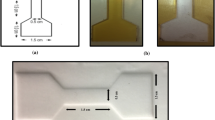Abstract
The negative and positive piezoresistivity in continuous carbon fiber epoxy-matrix composite has been clarified. The negative piezoresistivity associated with the increase of the through-thickness resistivity upon longitudinal tension and decrease in the through-thickness resistivity upon longitudinal compression is practically attractive for strain sensing and is attributed to the decrease in the degree of contact between fibers of adjacent laminae upon longitudinal tension. This effect is stronger, more reversible and less prone to causing minor damage for the tension case than the compression case. The positive piezoresistivity associated with the longitudinal resistivity increasing upon longitudinal tension is negligibly weak, if any, independent of the number of laminae. The previously reported negative piezoresistivity associated with the longitudinal resistivity decreasing upon longitudinal tension does not occur for a commercially manufactured composite in which the fibers are well aligned.







Similar content being viewed by others
References
Grimaldi C, Maeder T, Ryser P, Strassler S (2003) Phys Rev B 67:014205/1
Wen S, Chung DDL (2005) J Mater Sci 40:3897
Wang X, Fu X, Chung DDL (1998) J Mater Res 13:3081
Wang X, Chung DDL (1998) Composites: Part B 29B:63
Arlen M, Koerner H, Taylor BE, Alexander MD, Vaia R (2006) Abstracts of Papers, 231st ACS National Meeting, Atlanta, GA, USA, March 26–30, POLY-357, American Chemical Society, Washington D.C
Eickhoff M, Ambacher O, Krotz G, Stutzmann M (2001) J Appl Phys 90:3383
Pavlov AN, Raevskii IP (2002) Phys Solid State (Translation of Fizika Tverdogo Tela (Sankt-Peterburg)) 44:1748
Morten B, Taroni A (1975) Lett Nuovo Cimento Soc Italiana Fisica 14:305
Todoroki A, Yoshida J (2004) JSME Int J A 47:357
Leong C, Wang S, Chung DDL (2006) J Mater Sci 41:2877
Wang S, Chung DDL (2006) Carbon 44:2739
Wang S, Kowalik DP, Chung DDL (2004) Smart Mater Struct 13:562
Todoroki A, Yoshida J (2005) Key Eng Mater 297–300(Pt. 1, Advances in Fracture and Strength):610
Gordon DA, Wang S, Chung DDL (2004) Composite Interfaces 11:95
Wang X (1997) PhD dissertation, State University of New York at Buffalo
Wang S, Chung DDL, Chung JH (2005) J Mater Sci 40:6463
Wang S, Chung DDL (2000) Polym Compos 21:13
Angelidis N, Khemiri N, Irving PR (2002) In: Balagcas DL (ed) Proc first European workshop structural health monitoring 2002, DEStech Publication, Lansacter, Pennsylvania, USA, pp 477–484
Wang S, Chung DDL unpublished result
Wang X, Chung DDL (1998) Composite Interfaces 5:191
Author information
Authors and Affiliations
Corresponding author
Appendix: Glossary
Appendix: Glossary
Negative piezoresistivity A: the resistivity in the through-thickness direction increasing upon uniaxial tension in the longitudinal direction.
Negative piezoresistivity B: the resistivity in the transverse direction decreasing upon uniaxial tension in the longitudinal direction.
Negative piezoresistivity C: the longitudinal resistance decreasing upon compression in the through-thickness direction.
Negative piezoresistivity D: the longitudinal resistivity decreasing upon uniaxial tension in the longitudinal direction.
Positive piezoresistivity A: the contact electrical resistivity of the interlaminar interface decreasing upon compression in the through-thickness direction.
Positive piezoresistivity B: the longitudinal resistivity increasing upon uniaxial tension in the longitudinal direction.
Positive piezoresistivity C: the longitudinal resistivity increasing upon longitudinal tension when the two-probe method is used.
Positive piezoresistivity D: the resistance in the transverse direction increasing with transverse strain/stress.
Rights and permissions
About this article
Cite this article
Wang, S., Chung, D.D.L. Negative piezoresistivity in continuous carbon fiber epoxy-matrix composite. J Mater Sci 42, 4987–4995 (2007). https://doi.org/10.1007/s10853-006-0580-z
Received:
Accepted:
Published:
Issue Date:
DOI: https://doi.org/10.1007/s10853-006-0580-z




